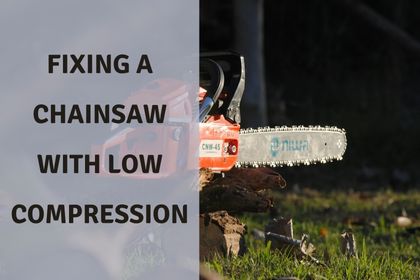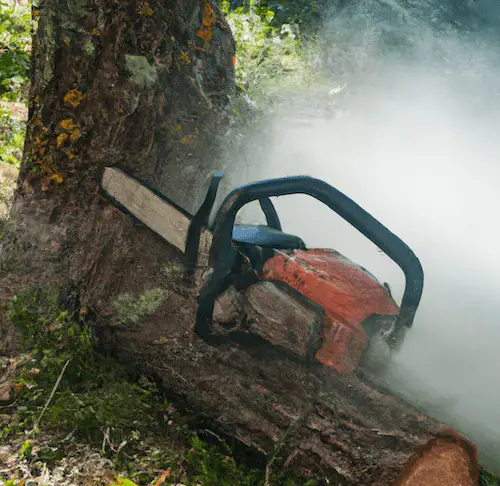Does your chainsaw have low compression? Low compression is a common issue in chainsaws and can lead to reduced power or even complete shutdown.

The good news is that it’s usually easy to diagnose and fix.
So let’s get straight into what causes low compression in chainsaws and how you can fix the problem.
Diagnosing Low Compression
The first step in fixing low compression issues with your chainsaw is diagnosing the problem.
Use this chainsaw compression tester to get an accurate reading of your chainsaw’s current compression levels. Follow the manufacturer’s instructions on how to use it correctly.
- A simple way to check for low compression is to place the chainsaw on the ground and pull the starter rope. If you notice that it doesn’t turn over, then it’s likely that your chainsaw has low compression.
- Another way to diagnose low compression is by removing the spark plug and checking the condition of the piston. If it’s heavily worn, then this could be causing a loss of compression in the engine.
- If the engine starts but quickly dies, then you likely have a low-compression issue.
- If you have piston or ring damage to the engine, then that could also be the cause of the low compression.
Fixing Low Compression in Your Chainsaw
Once you’ve identified that your chainsaw has low compression, you’ll need to take steps to fix it.
For a petrol-powered chainsaw to function smoothly, it needs the right amount of compression in the engine.
The most common cause of low compression in a chainsaw is an air leak in the cylinder head gasket or piston ring seal. Replacing these parts should solve the problem.
If you check and notice they are not damaged, then it’s likely that one of your spark plug wires has come loose or become disconnected. This can also cause decreased compression and should be checked as well.
You may also need to replace your piston rings if they are worn out or damaged beyond repair due to wear and tear over time.
The piston rings help to contain the force from the combustion so that it can be used to push the piston down the cylinder and turn the crankshaft.
If they are worn out, then this will reduce the amount of compression in the engine, resulting in a decrease in power or preventing the engine from starting at all.

If this is the case, then you will need to take apart your engine and replace them yourself or take it into a shop for repair. Remember that you should read your owner’s manual before you try to fix your chainsaw. If you don’t think you can do it, it is a good idea to let someone who knows how to do it for you.
Finally, if none of these solutions work, then it could be an issue with your carburetor not providing enough fuel for combustion or your spark plug being faulty – both of which will require professional help from an experienced technician who specializes in chainsaw repair.
How much compression should a chainsaw have?
Typically, standard-sized chainsaws should demonstrate a compression level between 110 PSI and 160 PSI. If your chainsaw exhibits a compression above or below this range, it signifies a potential problem.
This could range from air leaks to loose spark plugs or worn piston rings, all common culprits for low compression, which often results in reduced power or a sudden shutdown.
Fortunately, it’s not very difficult to diagnose these issues. You might need a compression tester, or you could check if the engine starts but quickly drops off.
These symptoms often denote worn-out parts or the need for certain adjustments. If you’re not confident conducting these checks, then you need to book a professional repair.
If your chainsaw’s reading is too high (over 160 PSI), then its engine could be too powerful for its own good and needs to be adjusted accordingly.
The key to a smoothly running chainsaw is keeping it in balance, neither too weak nor too strong.
A higher compression can mean more power and efficiency; a lower compression can cause poor engine performance or even engine failure.
If you want to get an accurate reading of your chainsaw’s current compression, you will need to buy a chainsaw compression tester and follow the manufacturer’s instructions on how to use it correctly.
You need to keep doing regular checks on your chainsaw, tighten plugs where necessary, and replace worn-out parts to mitigate against low compression.
Regular maintenance is critical in preventing such difficulties, ensuring your chainsaw’s longevity and functionality.
Final Thoughts
Low compression in your chainsaw can be caused by several different issues such as excessive wear on parts like piston rings and valves, air leaks, improper spark plug gap or idle speed settings, etc.
Fortunately, many of these issues are easy to diagnose and repair using either OEM-approved replacement parts or simple adjustments made with basic tools and knowledge found in your user manual.
By understanding what compression means and knowing what readings indicate a healthy engine, you’ll be able to make sure that your saw performs up to par every time you use it.

